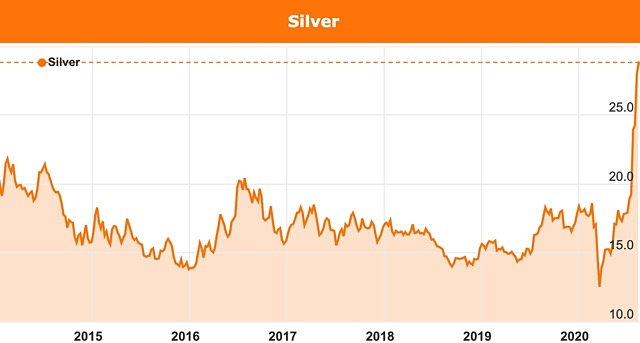Silver mine production faces challenges due to COVID-19, global output to drop 6.4%

Australian projects are in focus as silver production here grew 6.6% in 2019 driven by higher output from lead-zinc mines.
With the silver price soaring as safe haven demand kicks in among investors comes the news that mine output is certainly going to be disrupted in 2020 due to the global pandemic — but no one knows how badly.
According to the Silver Institute’s World Silver Survey 2020, the situation as it relates to mining is evolving on a daily basis “so, accurate predictions are challenging”.
The institute has estimated mined output will be down 54.5 million ounces, or 1,694 tonnes, representing a 6.4% decline.
China will “undoubtedly” have had mining impacted by COVID-19 but by an unknown amount, as most of its silver production comes from lead-zinc operations, the report continued.

Silver prices have rallied in recent weeks.
Other major silver producers, including Bolivia, Mexico and Peru, have implemented nationwide lockdowns resulting in temporary closures of silver mines. Canada has suspended mining operations in Quebec province although mines in other provinces remain open.
While silver producing mines in Australia, Russia and the United States are operating as normal, the Silver Institute believes there is a risk these countries could introduce COVID-19 measures where mining could be affected.
This comes on top of the 35Moz (or 1,091t) of silver that was “lost” in 2019, due mainly to industrial and community actions.
Blockades by truck drivers and landowners closed the Penasquito mine in Mexico for a total of 90 days while strikes occurred in Bolivia and Peru.
Two large mines (Fresnillo in Mexico and Pan American Silver in Argentina) experienced unexpected declines in grades.
Silver has been in surplus for seven out of 10 years
The structural surplus in silver continued in 2019 with supply exceeding demand by 31.3Moz (973t). The period from 2010 to 2019 saw silver market surpluses in seven of those 10 years.
But, that may not be as negative as it first appears: the Silver Institute said data collection in recent years has been better and it may be that previously unidentified inventories have shifted to vaults that report holdings.
Last year, silver bullion stocks held at London vaults rose by 24.5Moz (761t), while Comex inventories rose by 23.3Moz (724t).
“It is worth noting that the rise in Comex stocks was far smaller than the one we had seen in 2018, reflecting higher local demand,” the report said.
But lower grades have seen mined silver output fall
Global mined silver production in 2019 fell for the fourth consecutive year, down by 1.3% to 836.5Moz (26,019t).
This was the result of declining grades at large silver mines, lower silver output from copper mines and disruptions at some operations.
Production from primary silver mines fell by 3.8%, while silver sourced from lead-zinc mines rose by 2.3%.
Production in Australia grew 6.6% year on year to 42.9Moz (1,334t), driven by higher output from lead-zinc mines such as Mount Isa and the Century tailings project.
Australian focus now on primary silver plays
The Silver Institute notes the importance of silver as a by-product, with 71% of mined silver production in 2019 coming from lead-zinc, copper and gold mines.
But it would seem, from market action and media coverage, that there is growing focus on primary silver projects in Australia.
In recent weeks, Small Caps has been reporting on silver developments by Australian explorers.
Argent Minerals (ASX: ARD) is back on the ground after four years and now drilling at its Kempfield copper-gold-silver project located on New South Wales’ Lachlan Fold Belt.
Located 41km south of the Newcrest Mining (ASX: NCM) operation at Cadia, Kempfield is Argent’s’s flagship project, 100% owned and a NSW-designated state significant development.
The Kempfield polymetallic project has, from previous exploration, a JORC resource of 52Moz of silver equivalent.
Silver Mines (ASX: SVL) is expanding its diamond drilling campaign at its Bowdens project in NSW to up to 10,000m as a fast-rising silver price will mean increased investor focus on potential new exploration projects.
The primary targets of the drilling campaign are the high-grade silver lying below the current proposed pit and “multiple” new targets to extend the existing mineral resource.
Drilling is expected to continue until “at least” the end of 2020.
Investigator Resources (ASX: IVR) has just raised $8 million to advance its Paris silver project located in pastoral country on South Australia’s Eyre Peninsula, the site 60km northwest of the town of Kimba.
Investigator has a resource of 9.3 million tonnes at an average 139 grams per tonne silver and 0.6% lead for a contained 42Moz of silver and 55,000t of lead.
Mithril Resources (ASX: MTH) has begun drilling its Copalquin silver project in Mexico; the fully funded program is expected to continue until the end of 2020.
Previous drilling there between 1998 and 2007 returned 17.7m at 45.16g/t gold and 118g/t silver, and 7.9m at 6.54g/t gold and 140g/t silver.
While Azure Minerals (ASX: AZS) has diverted its focus to projects in Western Australia due to COVID-19 inhibiting its work program in Mexico, the company has assured shareholders it is not abandoning its silver plans there.
Azure managing director Tony Rovira recently said the company made the move due to the severity of the COVID-19 pandemic in Mexico and the uncertainty of future field operations.
But, he stressed that Azure was not losing interest in that country.
“It’s important for our shareholders to understand that our projects in Mexico remain an important core business for the company,” Mr Rovira said.
